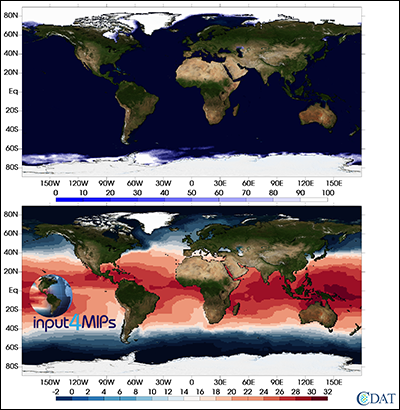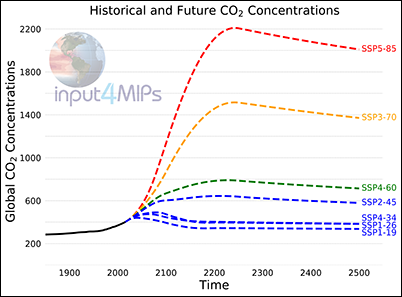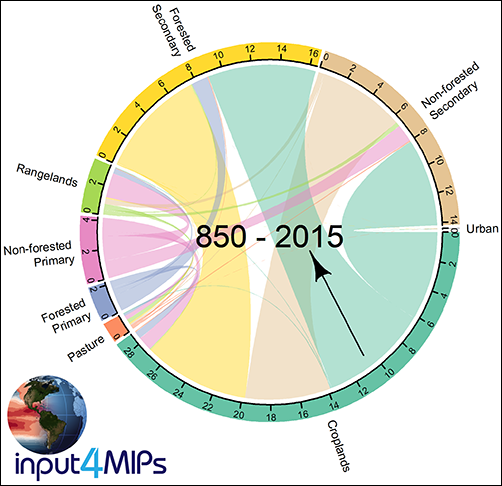Climate models are the most powerful tools for investigating global climate changes caused by human activity. These models are based on mathematical representations of the physics, chemistry, and biology of the climate system. The ways these models respond to externally imposed conditions, often representing the past or a hypothesized future, help scientists understand the forces and processes responsible for long-term changes in Earth’s climate.
Although climate models have improved over time, no single model perfectly represents all aspects of the climate system. Thus, rather than depending on the veracity of a single model, scientists rely on simulations by multiple models, each with its own strengths and limitations, to provide a range of likely outcomes. Each new model version revisits key standard experiments, providing scientists with a perspective concerning the robustness of results. The key to this strategy is that each model is “forced” by the same set of externally imposed conditions.
For the first time, the forcing data sets used in generating climate simulations of the past, present, and future will be collected, centrally archived, and documented.
The World Climate Research Programme (WCRP) Coupled Model Intercomparison Project (CMIP) has led the effort to coordinate international climate model experimentation. A critical element in the CMIP protocol is determining what forcing data sets are most suitable for each experiment. In the past, it was not essential to formally document every aspect of every simulation because model simulations were mainly of interest to the climate modeling groups themselves; modelers were well aware of the experiment design and the forcing applied. Now, however, future climate projections from CMIP models may form part of the basis for high-stakes decisions, so it is imperative to strictly and formally document experimental conditions, including the “forcing” data used to drive simulations.
Phase 6 of the CMIP project (CMIP6) is currently under way, with the first data expected in mid- to late 2018. For the first time, the forcing data sets used in generating climate simulations of the past, present, and future will be collected, centrally archived, and documented under a new initiative known as input data sets for Model Intercomparison Projects (input4MIPs). Better provenance and comprehensive documentation provided by this initiative will improve consistency, reproducibility, and traceability of the suite of CMIP6 model results.
Charge of input4MIPs
In assessing the limits of our understanding of the climate system, scientists have exploited the results of CMIP and its predecessors. As far back as 1990, multimodel experimentation provided the basis for many of the conclusions of the Intergovernmental Panel on Climate Change assessment reports.
The first phase of CMIP was initiated in 1995. Along with the original Atmospheric Model Intercomparison Project (AMIP), CMIP inspired a profusion of other MIPs. The expansion of intercomparison activities underlies a new imperative in the most recent CMIP phase, CMIP6 , namely, to impose tighter coordination and more uniform reliance on a common, community-wide infrastructure.

In support of CMIP, the new input4MIPs initiative promises to improve transparency, documentation, and consistency in the forcing data sets that are imposed in climate simulations. Some of these data (Figure 1) are based on observations (e.g., sea surface temperatures or greenhouse gas concentrations needed to force simulations of historical and future climate change). Others, like the forcing data employed in the projections called for by ScenarioMIP, are based on hypothetical future conditions. The input4MIPs data products have been endorsed for CMIP6 use and are considered the best available for generating simulations of past, present, and future climate.
Meeting the Challenge
CMIP forcing data cover a broad range of prescribed quantities. Examples include greenhouse gas concentrations (Figure 2) or emissions, variability of the solar “constant,” and land use changes (Figure 3). For atmosphere-only simulations (AMIP), data include sea surface temperatures and sea ice concentrations.
Until now, the data sets prepared by experts from different scientific subdisciplines have not conformed to uniform standards; the data were hosted on different servers in whatever structure and format seemed convenient. This diversity impaired interpretation and required special coding for use. Some forcing data sets lacked version control and were poorly curated.

The CMIP experiment design requires that the same external conditions be specified across all models and that that these forcing data sets be well documented. Differences in model responses can then be attributed solely to differences in the model formulation (discounting uncertainty associated with climate noise).
To ensure that the same forcing data are applied in all CMIP6 simulations, input4MIPs now maintains the official forcing data set collection. Standards have been imposed, ensuring that all data are similarly structured and include metadata describing their contents, structure, and domain. These standards follow the CMIP6 model output conventions and, where possible, adopt the CMIP-mandated names for variables and attributes.
A special CMIP6 issue of Geoscientific Model Development documents each of the new forcing data sets, and an up-to-date summary of input4MIPs data is maintained on the input4MIPs project website. As the project matures, digital object identifiers (DOIs) will make each data set citable. These DOIs ensure that data provenance can be traced and data creators can be credited. All officially released contributed data versions will be archived by input4MIPs and remain accessible in perpetuity.
Managing Changes

Because input4MIPs is a research-based project, official releases of data might be flawed and require correction. Some data will be updated periodically and extended as new data become available. Input4MIPs has implemented strict version control of the data releases, which aids transparency and traceability.
The Earth System Grid Federation (ESGF) hosts and serves input4MIPs data alongside the CMIP data. The CMIP Panel released the initial CMIP6 Forcing Data sets for the CMIP Diagnosis, Evaluation, and Characterization of Klima (DECK) and historical simulations version 6.0 for use on 20 December 2016, and two subsequent versions have superseded this release: version 6.1.1 on 22 May 2017 and version 6.2 on 11 September 2017, as documented on the input4MIPs website. Table 1 provides a summary of current input4MIPs holdings.
Input4MIPs Holdings
Before a model is used in scientific studies, CMIP requires that output from a small set of well-established baseline experiments be made available for community scrutiny. Performing the CMIP DECK experiments and the CMIP historical simulation establishes a model’s credentials, and any improvements in model performance can be objectively determined. All data sets needed for the DECK and historical simulations are now available.
CMIP6 has endorsed additional MIPs that focus on gaps in our understanding of the climate system.
Building on the DECK and historical experiments, CMIP6 has endorsed additional MIPs that focus on gaps in our understanding of the climate system. The 23 CMIP6-Endorsed MIPs call for 285 climate experiments, and many of these require additional forcing data sets. Input4MIPs will, with some exceptions, collect these data sets, some of which are already available (Table 1, second section).
Many of the input4MIPs data sets build on those used in previous CMIP phases. Some have been revised to include newly acquired observational estimates and to be extended at least to the end of 2014; others have been expanded to include forcing needed by newer, more comprehensive models, like those for the carbon and nitrogen cycles (see Table 1 for details).
Ongoing Contributions and Future Evolution
The input4MIPs initiative represents the latest addition to the U.S. Department of Energy’s 30-year scientific leadership through the Program for Climate Model Diagnosis and Intercomparison (PCMDI). This program’s other efforts include scientific leadership of CMIP experiment design, development of climate and forecast conventions and data standards for CMIP, obs4MIPs, archiving of data from earlier CMIP phases, and ESGF development and operations. These efforts have fostered collaboration across more than 27 countries involved in the WCRP CMIP project.
With time, input4MIPs will include whatever new or revised data are needed in subsequent phases of CMIP. As the project matures and participants adhere more closely to the input4MIPs data specifications, the publication process will incorporate additional data set quality control checks. We also plan to partner with modeling groups to evaluate the impact on simulations of each new forcing data set prior to its acceptance for use in future CMIP phases.
Acknowledgments
Some work was performed under the U.S. Department of Energy by Lawrence Livermore National Laboratory under contract DE-AC52-07NA27344. We acknowledge support from the U.S. Department of Energy, Office of Science, Climate and Environmental Sciences Division, Regional and Global Model Analysis Program. The input4MIPs Citation Service is contributed by the Deutsches Klimarechenzentrum under grant 01LP1605A from the Bundesministerium für Bildung und Forschung. We are grateful to colleagues who work diligently to provide data compliant with input4MIPs project standards. We also thank Dan Lipsa (Kitware) for assistance with figure preparation. LLNL release LLNL-JRNL-729886. The authors declare that they have no competing financial interests.
| Table 1. Forcing Data Sets (Version 6.2.11) Generated for Use in the CMIP6 DECK, Historical, and Satellite MIP Experiments | |||
| CMIP6 DECK and Historical Simulations | |||
| Data Set | Temporal Range | Data Set Version | Documentation |
| Historical anthropogenic short-lived climate forcing (SLCF), carbon dioxide and methane emissions | 1750–2014 | 2017-05-18, 2017-08-30, 2017-10-05 (aircraft sulfur dioxide) | Hoesly et al. [2017a, 2017b, 2017c, 2017d, 2018] |
| Historical biomass burning emissions | 1750–2015 | 1.2 | van Marle et al. [2016, 2017] |
| Historical land use changes | 850–2015 | 2.1h | Land-Use Harmonization (LUH2), Hurtt et al. [2017] |
| Historical greenhouse gas historical concentrations | 0–2014 | 1.2.0 | Meinshausen and Vogel [2016], Meinshausen et al. [2017] |
| Historical stratospheric aerosols | 1850–2014 | 3.0.0 | Thomason et al. [2017] |
| Historical ozone | 1850–2014 | 1.0 | Hegglin et al. [2016a] |
| Historical nitrogen deposition | 1850–2014 | 2.0 | Hegglin et al. [2016b] |
| Solar forcing | 1850–2299 | 3.2 | Matthes et al. [2017a, 2017b] |
| Aerosol optical properties | 1850–2100 | 1.0 | Stevens et al. [2017] |
| Historical sea surface temperature (SST) and sea ice | 1870–2017 | 1.1.4 | Durack and Taylor [2018] |
| CMIP6-Endorsed MIP Forcing Data Sets | |||
| MIP/Data Set | Temporal Range | Data Set Version | Documentation |
| CFMIP: cloud feedbacks | 1.0 | Webb et al. [2017] | |
| C4MIP/OMIP: carbon isotopic | 1850–2015 | 1.1, 2.0 | Jones et al. [2016], Orr et al. [2017], Graven et al. [2017a, 2017b] |
| DAMIP: ozone | 1850–2014 | 1.0, 1.1 | M. I. Hegglin et al. (database in preparation), Plummer et al. [2017, 2018a, 2018b, 2018c] |
| DCPP: idealized SST restoring fields | 1900–2013 | 1.1 | Boer et al. [2016], Cassou et al. [2017a, 2017b] |
| FAFMIP: heat and freshwater forcing fields | Idealized future | 2.1.0 | Gregory et al. [2016], Gregory [2018] |
| HighResMIP: SST and sea ice boundary conditions | 1948–2014 | 2.2.0.0-r0 | Haarsma et al. [2016], Kennedy et al. [2017] |
| OMIP (JRA55-do): ocean boundary conditions | 1958–2018 | 1.3 | Griffies et al. [2016], Orr et al. [2017], Tsujino et al. [2018], Graven et al. [2017a, 2017b] |
| RFMIP: atmospheric conditions for offline radiative transfer calculations | 0.4 | Pincus et al. [2016], Pincus [2017] | |
| ScenarioMIP (several data sets are pending)a | 2015–2100 or 2500; TBD | 2.1f; 1.2.0; TBD | LUH2; Meinshausen et al. [2017]; TBD |
aTBD = to be determined.
References
Boer, G. J., et al. (2016), The Decadal Climate Prediction Project (DCPP) contribution to CMIP6, Geosci. Model Dev., 9, 3,751–3,777, https://doi.org/10.5194/gmd-9-3751-2016.
Cassou, C., et al. (2017a), input4MIPs.CNRM-Cerfacs.SSTsAndSeaIce.DCPP.DCPP-C-amv-1-1, Earth Syst. Grid Fed., https://cera-www.dkrz.de/WDCC/meta/CMIP6/input4MIPs.CMIP6.DCPP.CNRM-Cerfacs.DCPP-C-amv-1-1, in press.
Cassou, C., et al. (2017b), input4MIPs.CNRM-Cerfacs.SSTsAndSeaIce.DCPP.DCPP-C-ipv-1-1, Earth Syst. Grid Fed., https://cera-www.dkrz.de/WDCC/meta/CMIP6/input4MIPs.CMIP6.DCPP.CNRM-Cerfacs.DCPP-C-ipv-1-1, in press.
Durack, P. J., and K. E. Taylor (2018), PCMDI AMIP SST and sea-ice boundary conditions version 1.1.4, version 20180427, Earth Syst. Grid Fed., https://doi.org/10.22033/ESGF/input4MIPs.2204.
Graven, H., et al. (2017a), Compiled historical record of atmospheric delta13CO2 version 1.1, version 20170807, Earth Syst. Grid Fed., https://doi.org/10.22033/ESGF/input4MIPs.1601.
Graven, H., et al. (2017b), Compiled historical record of atmospheric delta14co2 version 2.0, version 20170807, Earth Syst. Grid Fed., https://doi.org/10.22033/ESGF/input4MIPs.1602.
Gregory, J. M. (2018), input4MIPs.CMIP6.FAFMIP.NCAS.NCAS-2-1-0, version 20180118, Earth Syst. Grid Fed., https://doi.org/10.22033/ESGF/input4MIPs.1885.
Gregory, J. M., et al. (2016), The Flux-Anomaly-Forced Model Intercomparison Project (FAFMIP) contribution to CMIP6: Investigation of sea-level and ocean climate change in response to CO2 forcing, Geosci. Model Dev., 9, 3,993–4,017, https://doi.org/10.5194/gmd-9-3993-2016.
Griffies, S. M., et al. (2016), OMIP contribution to CMIP6: Experimental and diagnostic protocol for the physical component of the Ocean Model Intercomparison Project, Geosci. Model Dev., 9, 3,231–3,296, https://doi.org/10.5194/gmd-9-3231-2016.
Haarsma, R. J., et al. (2016), High Resolution Model Intercomparison Project (HighResMIP v1.0) for CMIP6, Geosci. Model Dev., 9, 4,185–4,208, https://doi.org/10.5194/gmd-9-4185-2016.
Hegglin, M., et al. (2016a), CCMI ozone in support of CMIP6 – version 1.0, version 20160711, Earth Syst. Grid Fed., https://doi.org/10.22033/ESGF/input4MIPs.1115.
Hegglin, M., et al. (2016b), CCMI nitrogen fluxes in support of CMIP6 – version 2.0, version 20161207, Earth Syst. Grid Fed., https://doi.org/10.22033/ESGF/input4MIPs.1125.
Hoesly, R., et al. (2017a), Historical emissions (1750 – 2014) – CEDS – v2017-05-18, version 20170519, Earth Syst. Grid Fed., https://doi.org/10.22033/ESGF/input4MIPs.1241.
Hoesly, R., et al. (2017b), input4MIPs.PNNL-JGCRI.emissions.CMIP.CEDS-2017-08-30, version 20170907, Earth Syst. Grid Fed., https://doi.org/10.22033/ESGF/input4MIPs.1604.
Hoesly, R., et al. (2017c), Supplemental historical emissions (1750 – 2014) – CEDS – v2017-05-18, version 20170519, Earth Syst. Grid Fed., https://doi.org/10.22033/ESGF/input4MIPs.1242.
Hoesly, R., et al. (2017d), input4MIPs.PNNL-JGCRI.emissions.CMIP.CEDS-2017-10-05, version 20171006, Earth Syst. Grid Fed., https://doi.org/10.22033/ESGF/input4MIPs.1701.
Hoesly, R. M., et al. (2018), Historical (1750–2014) anthropogenic emissions of reactive gases and aerosols from the Community Emissions Data System (CEDS), Geosci. Model Dev., 11, 369–408, https://doi.org/10.5194/gmd-11-369-2018.
Hurtt, G., et al. (2017), input4MIPs.UofMD.landState.CMIP.UofMD-landState-2-1-h, version 20170126, Earth Syst. Grid Fed., https://doi.org/10.22033/ESGF/input4MIPs.1127.
Jones, C. D., et al. (2016), C4MIP – The Coupled Climate–Carbon Cycle Model Intercomparison Project: Experimental protocol for CMIP6, Geosci. Model Dev., 9, 2,853–2,880, https://doi.org/10.5194/gmd-9-2853-2016.
Kennedy, J., et al. (2017), input4MIPs.MOHC.SSTsAndSeaIce.HighResMIP.MOHC-HadISST-2-2-0-0-0, version 20170505, Earth Syst. Grid Fed., https://doi.org/10.22033/ESGF/input4MIPs.1221.
Matthes, K., et al. (2017a), Solar forcing for CMIP6 (v3.2), Geosci. Model Dev., 10, 2,247–2,302, https://doi.org/10.5194/gmd-10-2247-2017.
Matthes, K., et al. (2017b), input4MIPs.SOLARIS-HEPPA.solar.CMIP.SOLARIS-HEPPA-3-2, version 20170103, Earth Syst. Grid Fed., https://doi.org/10.22033/ESGF/input4MIPs.1122.
Meinshausen, M., and E. Vogel (2016), input4MIPs.UoM.GHGConcentrations.CMIP.UoM-CMIP-1-2-0, version 20160830, Earth Syst. Grid Fed., https://doi.org/10.22033/ESGF/input4MIPs.1118.
Meinshausen, M., et al. (2017), Historical greenhouse gas concentrations for climate modelling (CMIP6), Geosci. Model Dev., 10, 2,057–2,116, https://doi.org/10.5194/gmd-10-2057-2017.
Orr, J. C., et al. (2017), Biogeochemical protocols and diagnostics for the CMIP6 Ocean Model Intercomparison Project (OMIP), Geosci. Model Dev., 10, 2,169–2,199, https://doi.org/10.5194/gmd-10-2169-2017.
Pincus, R. (2017), input4MIPs.UColorado.radiation.RFMIP.UColorado-RFMIP-0-4, version 20170118, Earth Syst. Grid Fed., https://doi.org/10.22033/ESGF/input4MIPs.1121.
Pincus, R., P. M. Forster, and B. Stevens (2016), The Radiative Forcing Model Intercomparison Project (RFMIP): Experimental protocol for CMIP6, Geosci. Model Dev., 9, 3,447–3,460, https://doi.org/10.5194/gmd-9-3447-2016.
Plummer, R., et al. (2017), input4MIPs.CCCma.ozone.DAMIP.CCMI-hist-stratO3-1-0, version 20170814, Earth Syst. Grid Fed., https://doi.org/10.22033/ESGF/input4MIPs.1603.
Plummer, R., et al. (2018a), input4MIPs.CMIP6.DAMIP.CCCma.CCMI-hist-nat-1-1, version 20180525, Earth Syst. Grid Fed., https://doi.org/10.22033/ESGF/input4MIPs.2301.
Plummer, R., et al. (2018b), input4MIPs.CMIP6.DAMIP.CCCma.CCMI-hist-sol-1-1, version 20180525, Earth Syst. Grid Fed., https://doi.org/10.22033/ESGF/input4MIPs.2302.
Plummer, R., et al. (2018c), input4MIPs.CMIP6.DAMIP.CCCma.CCMI-hist-volc-1-1, version 20180525, Earth Syst. Grid Fed., https://doi.org/10.22033/ESGF/input4MIPs.2303.
Stevens, B., et al. (2017), MACv2-SP: A parameterization of anthropogenic aerosol optical properties and an associated Twomey effect for use in CMIP6, Geosci. Model Dev., 10, 433–452, https://doi.org/10.5194/gmd-10-433-2017.
Thomason, L., et al. (2017), input4MIPs.IACETH.aerosolProperties.CMIP.IACETH-SAGE3lambda-3-0-0, Earth Syst. Grid Fed., https://cera-www.dkrz.de/WDCC/meta/CMIP6/input4MIPs.CMIP6.CMIP.IACETH.IACETH-SAGE3lambda-3-0-0, in press.
Tsujino, H., et al. (2018), input4MIPs.CMIP6.OMIP.MRI.JRA55-do-1-3, version 20180412, Earth Syst. Grid Fed., https://doi.org/10.22033/ESGF/input4MIPs.2205.
van Marle, M. J. E., et al. (2016), Biomass burning emissions for CMIP6 (v1.2), version 20161213, Earth Syst. Grid Fed., https://doi.org/10.22033/ESGF/input4MIPs.1117.
van Marle, M. J. E., et al. (2017), Historic global biomass burning emissions for CMIP6 (BB4CMIP) based on merging satellite observations with proxies and fire models (1750–2015), Geosci. Model Dev., 10, 3,329–3,357, https://doi.org/10.5194/gmd-10-3329-2017.
Webb, M. J., et al. (2017), The Cloud Feedback Model Intercomparison Project (CFMIP) contribution to CMIP6, Geosci. Model Dev., 10, 359–384, https://doi.org/10.5194/gmd-10-359-2017.
Author Information
Paul J. Durack (email: [email protected]; @pauljdurack) and Karl E. Taylor, Program for Climate Model Diagnosis and Intercomparison, Lawrence Livermore National Laboratory, Livermore, Calif.; Veronika Eyring, Deutsches Zentrum für Luft- und Raumfahrt, Institut für Physik der Atmosphäre, Oberpfaffenhofen, Germany; Sasha K. Ames, Tony Hoang, Denis Nadeau, and Charles Doutriaux, Program for Climate Model Diagnosis and Intercomparison, Lawrence Livermore National Laboratory, Livermore, Calif.; Martina Stockhause, Deutsches Klimarechenzentrum, Hamburg, Germany; and Peter J. Gleckler, Program for Climate Model Diagnosis and Intercomparison, Lawrence Livermore National Laboratory, Livermore, Calif.
Citation:
Durack, P. J.,Taylor, K. E.,Eyring, V.,Ames, S. K.,Hoang, T.,Nadeau, D.,Doutriaux, C.,Stockhause, M., and Gleckler, P. J. (2018), Toward standardized data sets for climate model experimentation, Eos, 99, https://doi.org/10.1029/2018EO101751. Published on 02 July 2018.
Text © 2018. The authors. CC BY-NC-ND 3.0
Except where otherwise noted, images are subject to copyright. Any reuse without express permission from the copyright owner is prohibited.

